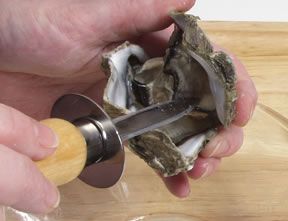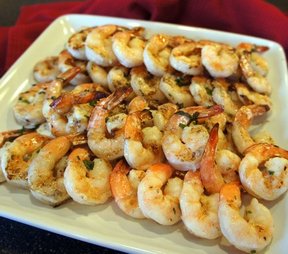|
What You Will Need
|

Pairing Knife
|
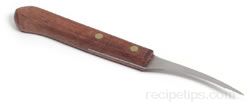
Deveining Tool |
Check for Freshness
- Fresh shrimp should smell clean, refrain from shrimp that smells of ammonia.
- At the fish market, fresh shrimp should be stored in or on ice.
- If you purchase frozen shrimp, avoid shrimp that was peeled and deveined prior to freezing. The practice of cleaning the shrimp before freezing may cause a loss of flavor and texture.
- Be aware of leakage or frozen surface ice on frozen shrimp. These are signs that the shrimp has been defrosted and refrozen and should be avoided.
| Tip: If your palate is sensitive to iodine, avoid brown shrimp. The taste of the naturally occurring iodine is most often apparent in brown shrimp. |
Preparing Shrimp
- "Refresh" frozen shrimp by soaking in salted water, 1 to 2 tbsp of salt to 1 quart of water.
- The best way to keep shrimp fresh while preparing them is to keep them in ice water. Return the cleaned shrimp to the ice water until you are ready to cook them. Pat the shrimp dry with a paper towel before cooking.
- Leave the shell on while boiling or steaming shrimp. The shell preserves the juices and natural flavors.
- The black vein that runs along the back of shrimp is the digestive tract. Typically, whether veins are in or out, seldom is there a flavor difference unless the vein is large and contains a high volume of grit and digested material. It is removed more for the appearance than taste. The decision to remove the digestive tract is based on personal preference.
| Prepping shrimp can be as simple as rinsing them in fresh water. If the recipe calls for removing the head, gently pull of the head and discard. Most often, shrimp is purchased with the head already removed. |
 |
| To remove the shell, begin by holding the shrimp firmly and pulling off the legs. |
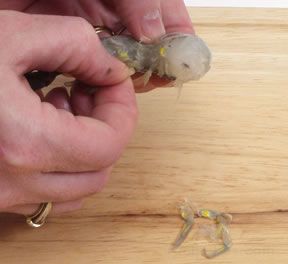 |
| An alternative technique is to remove the legs at the same time the shell is removed. Using your thumbs, peel back the sides of the shrimps shell. Pluck away any legs that remain after the shell has been removed. |
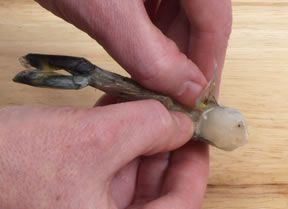 |
| Peel the shell away from the body. The tail of the shrimp can be removed at the same time by simply holding the body of the shrimp and pulling away the tail. The shell will come off with the tail. Removing the tail is optional. |
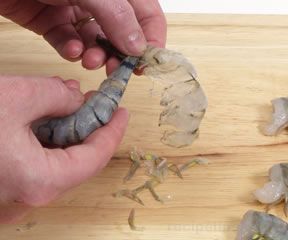 |
| To devein the shrimp with a small utility knife, make a shallow cut down the back of the shrimp to expose the vein. |
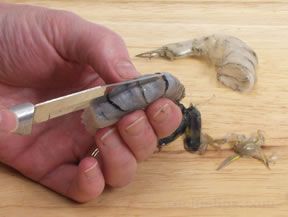 |
| Once the vein is exposed, pull the intestine out with the knife, a toothpick, or your fingers. |
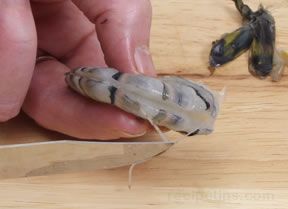 |
| It is not necessary to remove the shell prior to using a deveining tool. Insert the deveining tool under the shell and make a shallow cut following the curve of the knife. As the knife is pushed from the head to the tail of the shrimp, the vein will adhere to the serrated area of the knife while the sharp upper edge cuts the shell. |
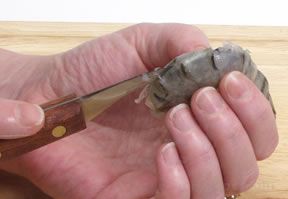 |
Storing Shrimp
- Fresh shrimp that has not been cooked is very perishable. Shrimp should be used within two days of purchase to ensure optimal taste.
- Store fresh shrimp that will not be cooked immediately in the coolest area of the refrigerator, preferably on ice and covered with waxed paper. The waxed paper allows air to circulate around the shrimp.
- Cooked shrimp that is stored in the refrigerator should be eaten within 2-3 days.
- Frozen shrimp, if packaged tightly, will last up to six months in most household freezers.
- Shrimp that has been frozen tends to lose texture.
- Once defrosted, shrimp should be kept refrigerated and used within three days.
- Once defrosted, do not refreeze shrimp.
|
















